Recently, friends with a similar RV contacted us regarding issues with their RV water filtration system. They wondered if we had the same issues of low water pressure and filters wearing out as quickly as they did.
We did not have the same issues, but we were considering updating our water filtration system. Our RV only has a single canister system and we wanted to learn more about our options.
We did many hours of research and actually interviewed the manufacturers at Clear2O® to learn more.
In this post, we’ll share what we learned about RV water filtration systems and how we were surprised to find out that our RV filter wasn’t doing what we thought it was!
Clear2O® offers 2 New Water Filtration options designed specifically for RVers. The CDC200 Dual Canister filtration system and DirtGUARD-The first-ever dual inline RV filter.
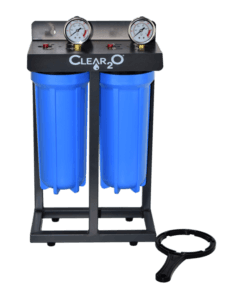
Photo Credit CLEAR2O
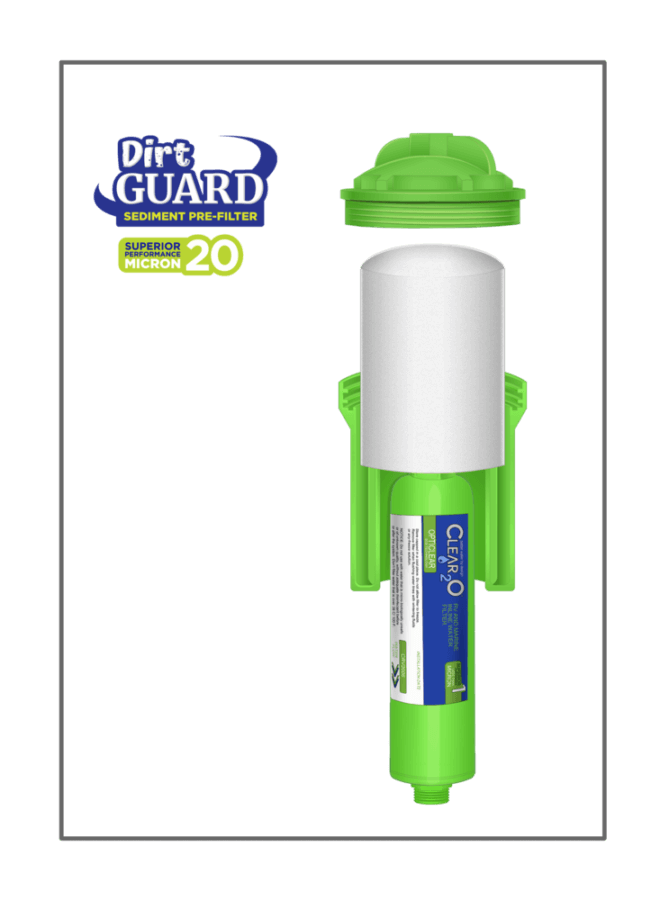
Photo Credit CLEAR2O
How Do RV Water Filters Work?
Most RV water filters are either a 1 or 2 stage canister or inline filter system. Before entering the RV plumbing, the water flows through the sediment filter to remove any large impurities, then (if equipped) flows through a second stage carbon filter to improve taste and eliminate odors.
Don’t Most RVs Already Have Built-In Water Filters?
Many RVs have a filter system in the wet bay designed to filter out the sediments that can clog your RV plumbing. They are normally single canister systems with disposable filters that should be changed every month or so depending on how often you use your RV.
This is the system we have in our Newmar Class A RV.
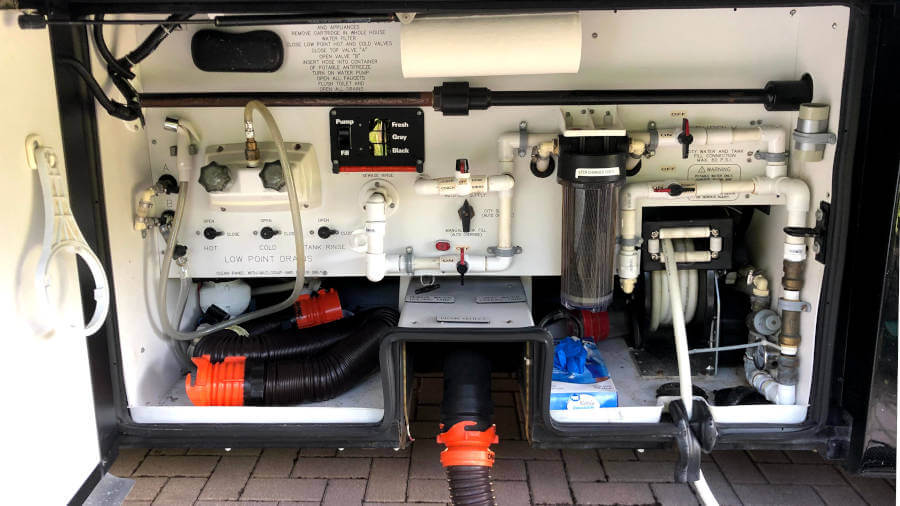
Photo Credit RV N Style
Do Single Canister Water Filters Work?
Yes and no. Single canister systems are generally the first line of defense to catch the big particulates that can be found in drinking water. Depending on the type of filter you use, they might also help with taste.
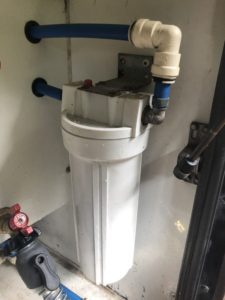
What If I Already Use A Carbon Filter, Isn’t That All I Need?
We thought that by using a carbon filter in our single canister water filter and changing it regularly, we were doing a good job filtering our RV water. It turns out that it is not entirely true!
We learned that while using a carbon filter on your RV certainly won’t hurt, if it is your only filter (as it was ours), they quickly get clogged.
Once clogged they are basically ineffective and can lower your water pressure inside your RV.
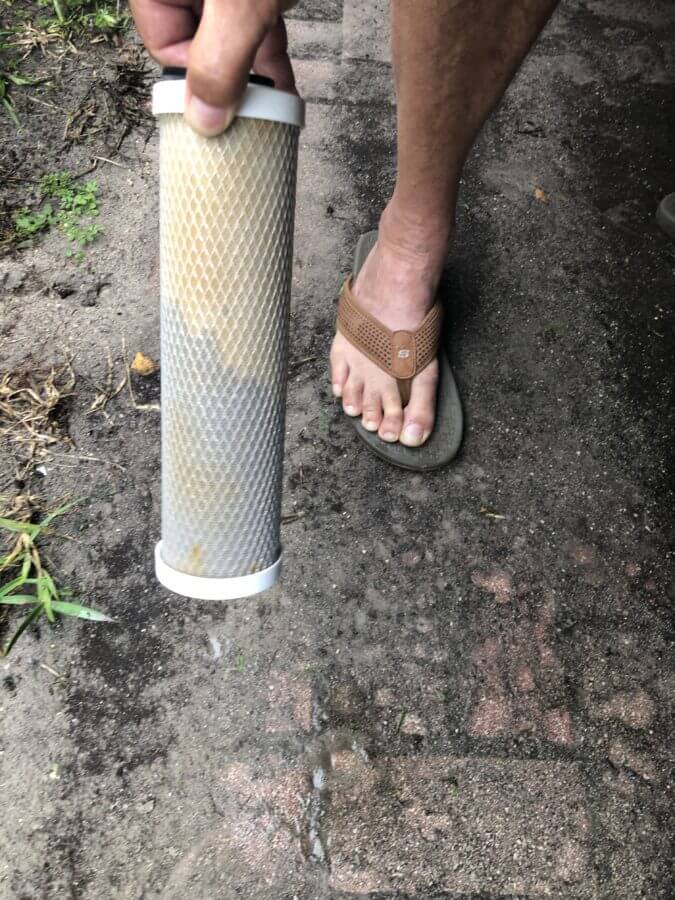
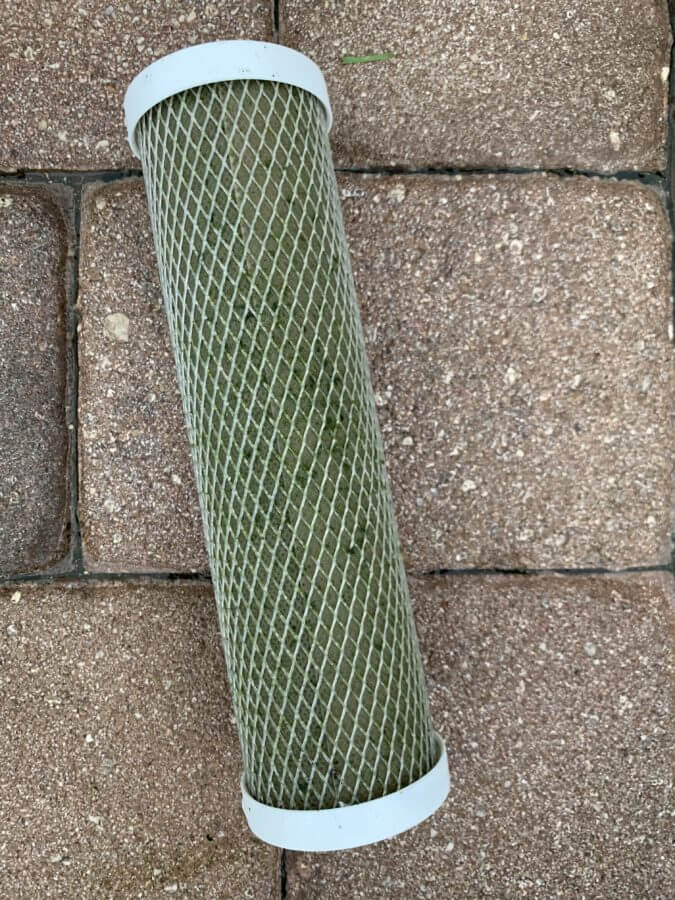
Tip: Always turn on the water at your RV site BEFORE you hook up your drinking water hose. Let it run a few minutes to flush out any sediment and old water in the lines so you don’t put any dirty water in your RV.
5 Types of RV Water Filtration Systems
Once we learned that we weren’t filtering our RV water as well as we thought, it was time to look into options. There are basically 5 types of RV Water Filtration Systems:
- Single Stage Canister Systems– like we currently have
- Dual Stage Canister Systems
- In-line Water Filters
- Reverse Osmosis Systems
- Three Stage Canister Systems- we ruled this one out since most people we talked to didn’t use theirs
Single Stage Canister System
If you don’t have the room to add a dual canister system to your RV, a single canister system will provide protection from sediments that can clog your RV plumbing.
You can purchase carbon filters that remove some level of taste and odor, but if you want cleaner water, a two-stage system is better.
What Is A Dual Stage RV Filter System?
A dual-stage RV water system is designed with a sediment filter as a prefilter and a carbon filter (or taste filter) as the second filter. These dual canister systems can be mounted inside your wet bay or sit outside your RV.
A dual filtration system provides the best protection against sediments and chemical contaminants that affect water taste, odor, and color.
Why Don’t All RVers Use Dual Canister Filtration Systems?
While we all agree that clean drinking water is a necessity for our RV, there are a few reasons why you may not want a dual canister system on your RV.
Size– One of the first reasons, not all RVs use dual canister systems is their size. These units are about two feet high by one foot wide, and you may not have the space to mount them in your wet bay.
Cost– Quality dual canister water filtration systems are in the $250-$300 range and are more expensive than inline filters. If you do not use your RV very often, it may not make sense to invest in a dual canister system.
New DIY RV Dual Canister System for RVs Now Available!
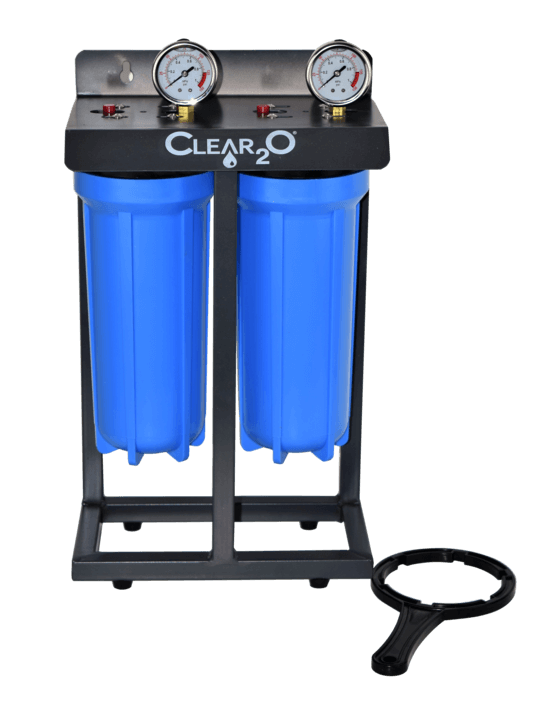
New for 2020- Clear2O® CDC200 Dual Canister Filter System
We were excited to learn about the newest RV filter system, the CDC200. This easy DIY RV Water Filtration System has a sturdy dual canister design that offers a higher flow rate and a longer filter life. The unit comes with a stand so it can be mounted in a wet bay or left freestanding.
We liked having the oil-filled pressure gauges on each canister so that we could easily see when one was clogged and it was time to replace it.
It has pressure relief valves to make it easy to change filters and they offer several different filter options.
The other reason we like the CDC200 is that they use a Solid Carbon Block Water filter made of 100% Coconut Carbon.
Why Use Coconut Shell Carbon Filters?
- Coconut carbon filters are more efficient than coal carbon filters in absorbing organic chemicals and pesticides.
- Coconut Carbon comes from a renewable resource (coconut shells), so it’s more eco-friendly than carbon.
- Water filtered with coconut carbon filters has a better taste than carbon filtered water.
New Technology in Carbon Filters
A quick lesson on carbon filters. Carbon filters are used to improve the taste and odor of water. There are three types of carbon filters and two of them are pretty new to the market. Unfortunately, carbon filters cannot be cleaned and once they are clogged, they lose their effectiveness and can reduce your RVs water pressure.
Granulated Carbon Filters (GAC)– The most common carbon water filters contain granulated activated carbon. While these filters do work, over time the water flow can create channels in the carbon. When that happens not all of the water is filtered through the carbon granules.
Since these filters are sealed, you really can’t tell by looking at them whether your filter is compromised. These are generally the least expensive filters.
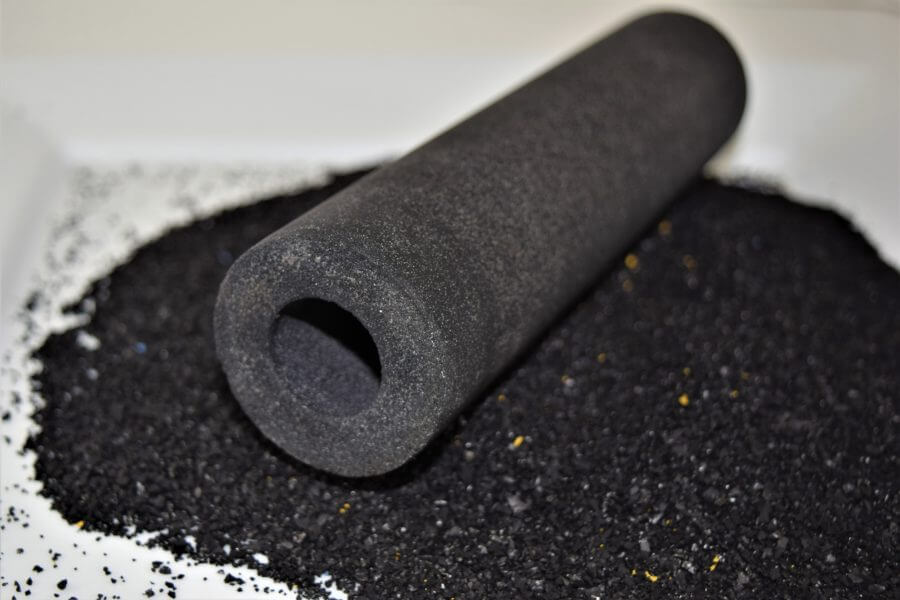
Solid Block Carbon Filters (SBC)– A better alternative to granulated carbon filters are solid block carbon filters (SBC). Water channels cannot form in the SBC filters, so the water always flows through the carbon. Additionally, they filter out more contaminants than GAC filters.
Modified Carbon Block Filters (MCB)– Modified carbon block filters are made from fibers in carbon particles. Many RVers select the MCB filters because the fiber material resists stagnating. They are very similar to SBC filters, except they offer better rates of flow, more variety of filtration choices and longer life.
Tip: It’s a good idea to always keep spare filters for your water filtration system and write the date you replaced them on the side of the filter.
The CDC200 is Amazon’s #1 New Release in Water Filtration Systems
After learning so much about RV water filtration, we decided to upgrade to the CDC200 dual canister system.
What Is An Inline RV Water Filter?
Inline RV water filters are normally attached to your RV’s drinking water hose. This is considered a single filter system and most use granulated carbon to filter water.
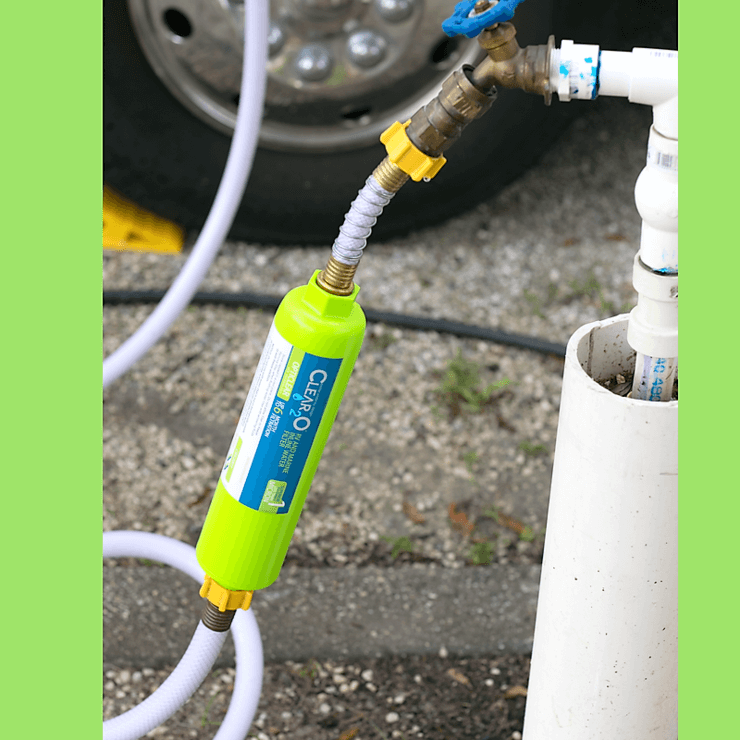
Clear2O® uses solid carbon block filters in their inline filter.
But again, once your inline carbon filter is clogged with sediment, it is pretty much useless.
Why Choose An Inline RV Water Filter Over A Dual Canister System?
If you don’t have space in your RV for a dual canister system, or you don’t use your RV often then an inline filter may be the better choice. It’s also the least expensive option.
Can Inline RV Filters Offer Two-Stage Filtration?
They will be able to soon! A company called Clear2O® recently invented the very first inline prefilter for sediments called DirtGUARD.

Planned to be released in the spring of 2020, this new invention will greatly improve the water quality for RVers that choose not to install a dual canister system.
How Does The Inline DirtGUARD Filter Work?
The DirtGUARD attaches to the hose before the carbon filter and then the carbon filter fits (or nests) inside of it. This 20-micron prefilter catches sediments before they flow through the carbon filter and keeps the carbon (or second stage) filter from being blocked.
Which Carbon Filters Does DirtGUARD Work With?
The folks at Clear2O® were clever enough to design this revolutionary filter to work with all of the major brands of inline filters.
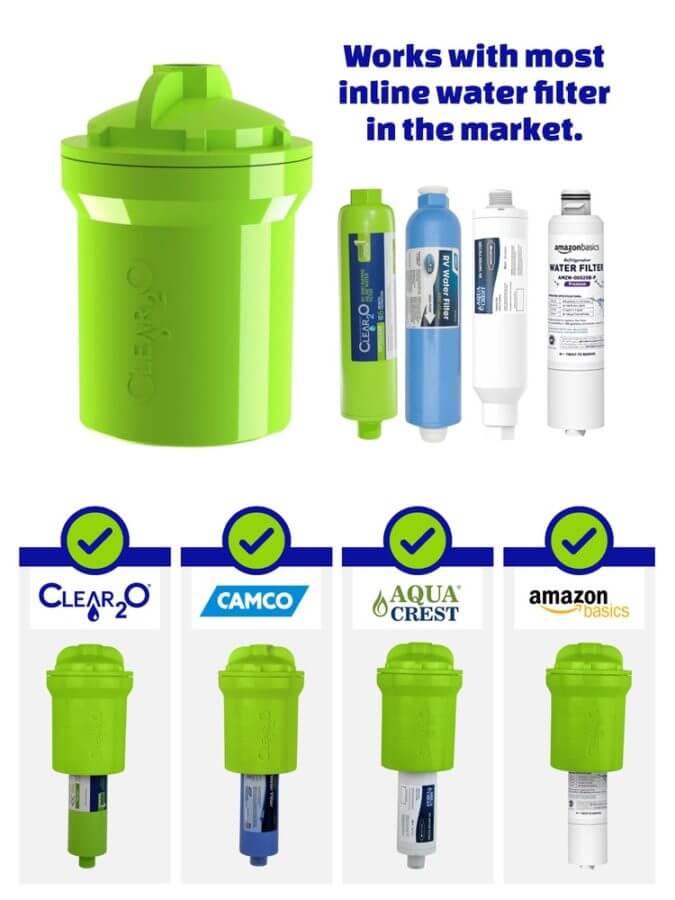
This means if you already have a stock of inline filters, you don’t have to buy new ones just to use this cool new prefilter.
Is DirtGUARD Easy To Install?
The DirtGUARD prefilter is very easy to install and no special tools are needed. You just screw in your drinking hose to one end, then add the carbon filter to the other and attach your second hose to the carbon filter and your RV.
How Long Does The DirtGUARD Prefilter Last?
Another great idea from the manufacturers was to make this filter reusable!
It’s made of high-density polyethylene (HDPE) and can be back-washed and scrubbed down to remove surface buildup. Then just reinstall.
Clear2O® estimates are you can run at least 1,000 gallons of water through it before replacing!
What Does The DirtGUARD Prefilter Cost?
MSRP of the DirtGUARD Sediment Prefilter, which includes a filter, wrench, and hose, is under $40.
DirtGUARD will be available in spring 2020 on the Clear2O® website, Amazon, and other online retailers. We’ll update this post with links once it has been released.
Tip: Always attach your inline water filters at the spigot end of your water hose instead of the end closest to the RV to catch impurities immediately rather than let them run through your drinking hose.
Reverse Osmosis RV Water Filtration
We also investigated using a Reverse Osmosis filtration system on our RV. This system uses a plastic membrane to filter everything out of the water, including all contaminants and minerals. This produces the purest water which sounds great, right?
Maybe not! Other than the high cost of installation (around $800 and the filters are expensive to replace), one of the biggest drawbacks to Reverse Osmosis systems is the amount of wastewater (called brine) it produces.
For every 1 gallon of purified water a reverse osmosis system produces, you get 4 gallons of brine!
Tips For Selecting The Right RV Water Filtration System
Pick Your RV Filtration System Based on Your Usage
The first thing you should consider when selecting your motorhome’s water filtration system is how often you use your RV. If you only use your RV occasionally and don’t use a lot of water, a Dual Inline Filter system might be all you need.
Drinking-Water Or A Whole RV Water Filtration System
Do you want to filter all of the water that you use on your RV, or just your drinking water? If you are full-timers or use your RV for long periods of time, a whole RV filtration system may be best.
Another reason to choose a whole RV filter system is if the areas you travel in most have poor water quality. You don’t want to shower or launder your clothes in smelly water!
In this case, a dual filtration canister system would be your best choice.
Tip: Even if you have a filtration system, if you are not consistently using your freshwater from your tank you will still need to sanitize your fresh water tanks occasionally.
Everyone’s needs are different and picking a water filtration system that works best for you will be as unique as the RV you choose!
Hopefully, our research will help you select the right water filtration system for your RV!
Visit CLEAR2O to learn more about their complete line of RV and Home Water Filtration Systems.
Does your RV water pump keep running? You may be interested in learning about Why Your RV Water Pump Pulsates and How to Fix It.

Not sure how hydronic heating works to supply constant hot water to your RV? Read How Does an Oasis Hot Water System Work.
People Also Ask
Is Campground Drinking Water Clean And Safe To Drink?
If the site you are in has not been used recently and flushed thoroughly, it may not actually be safe to drink.
Unless it is marked not potable, campground water may be safe to drink but that doesn’t mean it is going to taste good. It often contains high amounts of sediment, silt, sand, and even rust.
Do I Need a Water Filter For My RV?
Yes, even if you use bottled water for drinking, you should definitely have at least a sediment filter on your RV to keep sand, rust, silt, and other contaminants from clogging RV pipes and causing costly repairs.
